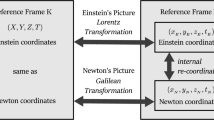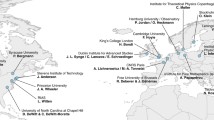Abstract
By a comparison between Maxwell's electrodynamics classically interpreted (MT) and relativistic electrodynamics (RED), this paper discusses whether the “asymmetries” in MT mentioned by A. Einstein in his 1905 relativity paper are only of a conceptual nature or rather involve specific empirical claims. It is shown that in fact MT predicts strongly asymmetric behaviour for very simple interactions, and an analysis is made of the extent of the “symmetry” achieved by means of relativistic postulates. A “low” velocity experiment is suggested which could provide another test of the accuracy of RED with respect to MT.
Similar content being viewed by others
References and notes
See R. Torretti,Relativity and Geometry (Pergamon Press, 1983), pp. 76–82, for details.
We quote from the translation given by A. I. Miller,Albert Einstein's Special Theory of Relativity (Addison-Wesley, Reading, Massachusetts, 1981), p. 392. In an unpublished 1919 essay Einstein wrote: “The phenomenon of the electromagnetic induction forced me to postulate the (special) relativity principle” (Miller, p. 145).
For an exception, see V. I. Arnold,Mathematical Methods of Classical Mechanics, translated by K. Vogtmann and A. Weinstein (Springer, New York, 1978), p. 10.
For an exception, see A. P. French,Special Relativity (MIT Press, Norton, New York, 1968), p. 259. Of course, from the aether-theoretic point of view, it is well possible that high absolute velocities imply “real modifications” in the shape of bodies, masses, and so on, which would require adjustments of the classical theory similar to the “relativistic” ones. Nevertheless, we claim thatit is in the low-velocity case that relativistic and classical predictions are certainly different.
W. Rindler,Essential Relativity (Springer New York, 1977), 2nd edn., p. 97. According to M. Bunge, inFoundations of Physics (Springer, Berlin, 1967), p. 197, RED “is not a new theory but a reformulation of CEM [classical electromagnetism], which was relativistic without knowing it.”
See, for instance, A. O'Rahilly,Electromagnetic Theory—A Critical Examination of Fundamentals (Dover, New York, 1965), Vol. II, p. 589. Clausius stated that “a closed constant current in a stationary conductor exerts no force on stationary electricity.”
With this choice, we intend to remember the name and the work of E. H. Kennard [see, for instance, “On unipolar induction—another experiment and its significance as evidence for the existence of the aether,”Philos. Mag. 33, 179–190 (1917)] and the multifarious activities of Stefan Marinov in favour of classical electrodynamics [cf. his many-volume workThe Thorny Way of Truth, I–IX, International Publishers “East-West”, Graz (Austria), 1982–1991, in press].
W. F. Edwards, C. S. Kenyon, and D. K. Lemon, “Continuing investigation into possible electric fields arising from steady conduction currents,”Phys. Rev. D 14(4) 922–938 (1976); R. Sansbury, “Detection of a force between a charged metal foil and a current-carrying conductor,”Rev. Sci. Instrum. 56(3), 415–417 (1985).
For another, conceptually very simple “electrodynamical” experiment to test RED which has never been performed properly, see J. Maddox, “Stefan Marinov's seasonal puzzle,”Nature (London) 346, 103 (1990).
Author information
Authors and Affiliations
Rights and permissions
About this article
Cite this article
Bartocci, U., Capria, M.M. Symmetries and asymmetries in classical and relativistic electrodynamics. Found Phys 21, 787–801 (1991). https://doi.org/10.1007/BF00733345
Received:
Revised:
Issue Date:
DOI: https://doi.org/10.1007/BF00733345




